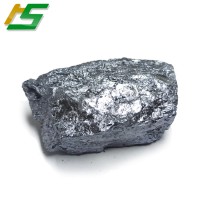The use of carbon to reduce silica is a more complex chemical thermochemical reaction than metal smelting. After comprehensive scientific research, the baSiC laws of the thermochemical reaction of metal silicon production are obtained, and from the silicon metal During the production process, the correctness and reference of the obtained laws were demonstrated.
The following is a brief description of the achievements and achievements of the industry's predecessors over the past 54 years, and we have further deepened our scientific understanding based on this.
Si-O system
In the Si—O system, the most stable “phase” is SiO 2 , which has a theoretical melting point of 1933 K (1660° C.) [displayed crystalline silica is 1414° C.] and a boiling point of 3048 K (2775° C.). The specific resistance at 1973K is 90Ω•m. Studies have shown that quartzite (SiO2) has more than ten variants in the “phase” transition of the heating process, ie, its crystal structure also follows and has a large volume change. At a metal temperature of 1143 to 2001K, from the quartz phase to the tridymite, its volume increase can reach 14.7%. Such a large volume change results in the occurrence of quartz (commonly known as silica) as a component of the burden material on the surface of the charge. Hot cracking. The higher the water-absorptive, conductive quartz component, the more severe the cracking.
In the metallurgical theory of metal silicon, a major theoretical breakthrough was the discovery of a new low-valence oxide of silicon—SiO. This was confirmed by recovering a large amount of SiO2 dust from a silicon metal duster. It can be further confirmed that oxide SiO plays a very important role in the smelting, and it is an essential intermediate product. The formation of SiO in the Si-O system:
In the liquid state: SiO2+Si=2SiO (1)
The relationship between equilibrium constant and temperature: LgPSiO=-(15200/T)+7.38
In the liquid state, evaporation of pure SiO2 presses the reaction to generate SiO:
SiO2=SiO+1/2O2 (2)
In 1773K to 1983K:
△G0=762240-244.06T
Therefore, to fully understand the baSiC theory of SiO formation and participation in the reaction in the furnace, one can clearly understand the importance of preventing the loss of generated SiO from the furnace mouth, reducing flue gas, reducing thermal energy dissipation, and eliminating dust dust (also known as microsilicon). Powder) is an important work to improve the efficiency of metallurgical furnaces and improve the technical and economic indicators of metallurgical furnaces.
2. Si-C system
In the smelting of metallic silicon, the understanding of SiC is also very important, because it is an indispensable product in the transition like SiO. During the smelting process, if it is produced in the solid state, the solid SiO2 reacts with the solid state C in the reducing agent as follows:
SiO2+3C=SiC+2CO (3) SiO2+C=SiC+O2 SiO2+2C=Si+2CO SiO2+4C= SiO+ SiC+3CO
△G0=555615-322.11T
If PCO=100Kpa, △G=0 at 1725K. Therefore, during the smelting reaction, a large amount of SiC will be generated at a relatively low temperature in the solid state, that is, when the reduction temperature is not reached. That is, if there is enough carbon and SiO2 has 100% contact with C, then SiO2 will all be converted to SiC (silicon carbide production is based on this theory).
* Liquid silicon and solid carbon, reacted in the following manner to produce SiC:
Si+C=SiC (4) Si+2C=Si+2CO
At 1683~2000K:
△G = -100600+34.9T,
At 2880K, △G=0. That is, SiC is stable before 2880 K, above which it will begin to dissociate.
* When gaseous SiO and excess C are at high temperatures, condensed SiC is produced as follows:
SiO+2C=SiC+CO (5) (normal: SiO+C=Si+CO SiO+SiC=2Si+O)
Under normal conditions, SiC does not melt but instead changes from a solid state to a gaseous state.
SiC will dissociate as follows to produce liquid silicon and solid carbon:
SiC→Si+C (6) or SiO2+0.5SiC=1.5SiO+0.5CO SiO2+2SiC= 3Si+2CO 2SiO2+SiC= 3Si+CO 0.5SiO2+SiC= 1.5Si+CO
Full understanding of the theory of SiC formation, dissociation, and participating in the reaction is important for reducing the residual amount of SiC in the furnace and for directing the furnace conditions.
3. Thermochemical reaction of carbon-reduced SiO2
In the production of metallic silicon, the total process of removing silicon from SiO2 with carbon can be expressed as:
SiO2+2C=Si+2CO (7)
△G0T=697390-359.07T
When the temperature reaches 1942K, it can be regarded as the initial reaction temperature.
Due to the activity of aC carbon, both aSi silicon and a SiO2 silicon dioxide are equal to one. So the equilibrium constant is KP=P2CO.
The logarithm of CO partial pressure: LgPCO=(-697390/38.308T)+9.37
The carbon in the batch produced in the submerged arc furnace is carried out according to the above reaction formula (7) and is called the theoretical amount of carbon. However, actually, the reduction of SiO2 by C at different temperatures is carried out by forming an intermediate product of solid SiC, gaseous SiO and agglomerated SiO. Therefore, the reaction process cannot be simply carried out by formula (7). The thermodynamic range of the production of metallic silicon must grasp the principle of phase equilibrium in the Si—O—C system where the concentration ratio between the elements and the alloy and the melting temperature cross-react with each other.
The large amount of heat (69~72% of the heat consumption) required for the reduction of metal silicon is mainly derived from the arc high-temperature combustion zone at the bottom of the electrode (working end), forming a gas hole in the combustion zone (also known as In the high-temperature reflection zone), in this very high temperature cavity, various intense and complex reactions such as melting, decomposition, ionization, vaporization, boiling, sublimation, and phase transition of the substance are performed. In order to study this complex system, we have established a visualized model of the reaction zone.
When we format this model, the resulting constraint (conservation) conditions are:
(1) When the vapor partial pressure of the "condensed phase" substances involved in the reaction is equal to the saturated vapor pressure of these substances, a balance of all evaporation and condensation reactions can be achieved in the system.
(2) Maintaining all possible reaction equilibriums of the system, including the mass balance of the chemical elements in the gas phase, and the balance of the compound atomization constants, and the equilibrium of the dissociation and compounding reactions in the system.
(3) The volume balance of the gas components in the system.
The above three equilibrium constraints may be fulfilled in the laboratory, but this limitation is an inevitable law, which reflects the reaction of the equilibrium of the basic substances in the model. According to the basic theory of thermodynamics, this model reveals the relationship between gas/liquid/solid phase and temperature and pressure in the initial reaction, intermediate reaction and end point reaction of metal silicon production. Therefore, we believe that in the submerged-arc electric furnace for smelting metallic silicon, there exists a reaction zone that resembles a “pot” and it should be used as the basis for establishing a model.
There have been metallurgical scholars who have studied and calculated this system based on the basic theory of thermodynamics:
(1) In this high-temperature Si—O—C system, there are four agglomerates that are: solid or liquid SiO2, C, SiC, and Si. CO, CO2, SiO, SiO2, O, O2, C, Si and SiC are present in the gas phase. These constitute the complete thermodynamic research system for the Si-O-C system.
(2) At the high temperature of arc burning in the helium reaction zone, the following reactions occur in the condensed phase (solid-liquid mixture) and gas phase.
1SiO2+C=SiO+CO (8)
LgKP=(-33445/T)+17.19
22 SiO2+SiC=3SiO+CO (9)
LgKP=(-75290/T)+34.45
3SiO+2C=SiC+CO (10)
LgKP=(4580/T)-0.14
4SiO2+Si=2SiO (11)
LgKP=(-33020/T)+15.05
5SiO+SiC=2Si+CO (12)
LgKP=(-9330/T)+4.35
6SiO+C=Si+CO (13)
LgKP=(-2420/T)+2.14
For this system, the total pressure of the gas phase is determined by the partial pressures:
P=PCO+Pco2+PSiO+Psio2+PO+Po2+PSi+Pc+PSiC=100 KPa.
Using the above relationship between the reaction equilibrium constants and the temperature, it is possible to calculate the partial pressure of vapors of all participating substances at the metallurgical temperature.
Under the condition of P=0.1MPa, the component state diagram of phase composition and composition in homogeneous mixture at different temperatures can be concluded as follows:
(1) The initial temperature of the interaction between C and SiO2 is SiC at 1754K. In the condensed liquid phase, there are C and SiO2 in addition to SiC.
The presence of C and SiO2 indicates that there is no balance of SiC.
(2) From 1754K up to 2005K, there is always a liquid SiO2 condensed phase.
(3) The formation of silicon carbon compounds should start from 1962K. Before the evaporation point, its amount will increase as the temperature continues to increase.
(4) SiO and CO are present in all gas phases, and the SiO concentration also increases significantly with increasing temperature.
Although the above-discussed reaction theory is very important, due to the fact that electrothermal coupling temperature measurement technology and PCL automatic control system have not been used before, the smelting temperature in the furnace is difficult to measure, which makes it possible to apply these theories when actually calculating the material balance of the metallurgical process. It has great limitations and is even strongly rejected. From the logical inference, the material chain that is reduced from SiO2 to Si by C can be summarized as the following five reactions:
(1) SiO2+3C=SiC+2CO (14)
(2)SiO2= SiO+1/2O2 (15)
(3)SiO+ SiC=2Si+ CO (16)
(4)SiC= Si + C (17)
(5) C+1/2 O2= CO (18)
Obviously, the above five reaction formulas cannot include all reaction processes of Si—O—C system, the only generation method of formula (14) is not SiC, and formula (15) is not the only generation method of SiO, nor is formula (16). The only way to generate silicon. Therefore, on the basis of the concept of the following example, a simple summary is presented for its complex multiphase reaction:
(1) The initial reactants define SiO2 and C.
(2) The liquid-gas transition phase defines SiC and SiO, the liquid-solid transition phase defines SiC and SiO2, and the solid-gas transition phase defines SiCO and SiO2.
(3) The reaction product defines Si and CO.
(4) Although some derivatization reactions are omitted, the omitted reaction is only a process reaction for the end-point reaction product, and its reaction result is also included in the above five reactions.
(5) Order (14~18) equations according to the basic theory of thermodynamics, and perform logical calculations in order. The calculation results indicate:
(a) The silicon produced by reaction (16) accounts for 66.67% of the total, and the rest of the silicon is generated by the dissociation of the remaining SiC (indirect, direct).
(b) The production of 1 ton of silicon theoretically requires SiO2 2443 Kg, C 1357 Kg. The weight ratio of the reaction product silicon to carbon monoxide is 1:2.
The above analysis of thermodynamics and the balance calculation results of the initial reaction, intermediate reaction, and material flow of the end-point reaction involved in the reaction material fully demonstrate its important significance in guiding the design and smelting of the metal silicon electric furnace.
(a) It is necessary to fully understand the theory of the formation and participation of the intermediate transitional phase SiO and SiC, with particular attention to their existence conditions and physicochemical transformation mechanisms.
(b) The design of the electric furnace must give the reaction process a sufficiently high reaction temperature condition.
(c) The guiding principle of process control is to firmly grasp the mass balance of SiC and SiO and reduce the SiO loss and the residual amount of SiC.



